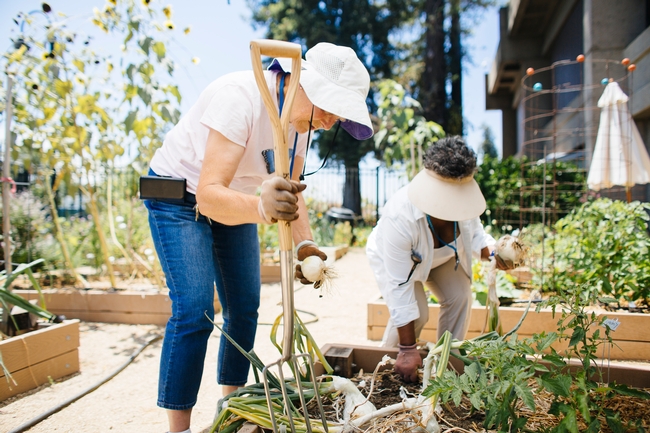A scorching summer heat wave is bringing triple digit temperatures and excessive heat alerts to much of California. The National Weather Service is predicting temperatures upwards of 105 and 115 degrees for several days in a row. Many home gardeners are wondering how they can help their plants, trees, or shrubs survive the intense summer heat.
“We are getting a lot of questions from around the state from people worried about how the extreme temperatures are going to affect the plants or trees in their yard,” says Missy Gable, director of the UC Master Gardener Program. “With a little extra planning, you can help your garden beat the heat and survive the hot summer weather.”
UC Master Gardener volunteers are available to help answer gardening questions and provide advice. Here are seven quick and easy ways to help make sure your plants and trees survive the hot summer months:
- Take care of yourself first, only garden during the cooler times of the day in the early morning or evening hours. Limit the time spent outdoors during the peak temperatures. Drink plenty of water, wear lightweight loose clothing, a brimmed hat, and work in the shade whenever possible.
- Shade your plants. Use a shade cloth, patio umbrella or other temporary structure to protect sensitive plants from the direct sun. This can reduce the heat stress on plants and prevent scorching of leaves.
- Water in the morning. Watering plants in the early morning helps to minimizes water loss due to evaporation, which is less prevalent during the cooler part of the day. This practice allows your plants to absorb water efficiently and become fully hydrated before the heat intensifies.
- Water trees deeply and less frequently. Water trees deeply and less frequently—yes, that's right, less frequently! The key is to water "deeply." Deep watering, promotes a robust network of deep roots, which helps the tree access water from deeper in the soil and become more drought-tolerant.
- Mulch, mulch, and more mulch. When temperatures get extreme, having a good layer of mulch prevents soil from heating up excessively and loosing water to evaporation. Apply 4-6 inches of a medium shred bark mulch to insulate the soil.
- Group container plants together: Placing container plants close to each other may help create a microclimate that retains moisture and reduces temperature fluctuations. Consider temporarily moving container plants to shadier areas.
- Watch for radiant heat. Pay special attention to plants located near walkways, patios, and other structures that radiate heat. These plants are often the first to show signs of heat stress and may require extra water to cope with the increased temperature.
- Don't fertilize plants or trees during hot summer months. Fertilizers aim to increase the growth of plants and trees. When a fertilizer is applied, especially one that is high in Nitrogen, a plant is triggered to produce more green growth. An increase in growth means an increase in water and nutrient needs. During hot spells, it is especially hard to keep up with plant water and nutrient needs as soils dry out quickly and water may not be readily available.
Thankfully,
we're not trying to garden on the surface of the sun. Unfortunately, sometimes it can feel like it. Stay cool, and don't forget to plan for your garden in the fall—it's the perfect excuse to stay inside with the air conditioning and an ice-cold beverage.
Ask your local UC Master Gardener Program
Have a gardening question? UC Master Gardener volunteers are available to help. Click here to Find a Program and connect with your local UC Master Gardener Program. You will be redirected to your local county website and contact information. UC Master Gardener volunteers are available to help answer questions for FREE. Happy gardening!
